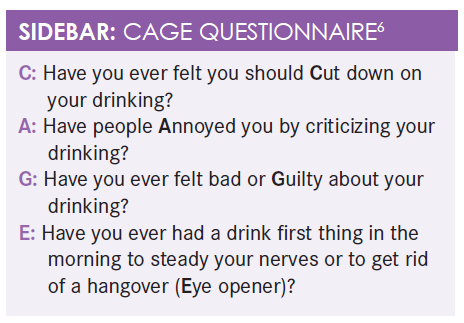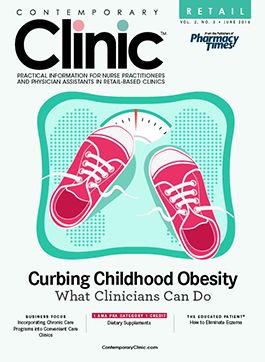DOT Exam FAQs: What Retail Clinicians Should Know
Retail clinics are the perfect location for conducting Department of Transportation medical examinations for commercial motor vehicle drivers.
Retail clinics are the perfect location for conducting Department of Transportation (DOT) medical examinations for commercial motor vehicle drivers. Nurse practitioners and physician assistants can perform a thorough patient history and physical exam and provide a nonbiased decision on whether to qualify a driver for the road. When filling out the DOT Medical Examination Report and Certificate, medical examiners must remember that they have 2 customers: the driver and the public. The key question the examiner must answer is whether the driver has any medical conditions that could affect his or her driving and potentially cause an accident. In 2013 alone, large trucks were involved in 3906 fatal crashes, 73,000 crashes that resulted in injury, and 265,000 crashes that involved property damage only, according to the Federal Motor Carrier Safety Administration (FMCSA).1
The FMCSA gives medical examiners guidelines and recommendations to assist them in making the best decisions for both drivers and the public. Specific parameters for hearing, vision, and blood pressure are outlined. Guidelines and time frame are available to help the medical examiner make the best medical judgment about whether a driver is safe to drive. When additional information is needed to make a decision, the medical examiner can ask the driver to bring in his or her health history and test results from primary care providers and specialists for review.
Pending documentation classification is a new option effective with the medical examiner’s certificate forms that went into effect on December 22, 2015. This classification is perfect for both the medical examiner and the driver if further medical history and test results are needed. If the driver’s current medical examiner certificate is still valid, he or she can continue to drive up to 45 days as long as the certificate has not expired. This allows the driver time to gather the necessary information while still being able to work. If the driver’s certificate has expired, he or she will not be able to drive. In addition, if the driver does not return with the information within 45 days and the medical examiner is unable to make a medical decision, then the driver’s current medical examiner certificate will become invalid.
Is the driver disqualified if I find abnormal results in the urinalysis?
Abnormal urinalysis results, including glycosuria, hematuria, and proteinuria, are not automatic disqualifiers for certification. However, these findings may indicate a need for further testing to determine whether the driver is medically fit to drive. If glucose is found in the urine, the provider may elect to test the driver’s blood sugar and/or hemoglobin A1C. The FMCSA handbook indicates that a person whose hemoglobin A1C level is higher than 10% has poor diabetes control2and will need further evaluation and possibly referral to a specialist to determine whether he or she is medically fit to drive.
If the urinalysis results combined with other medical findings indicate the potential for renal dysfunction, the driver should be referred to his or her primary care physician for further evaluation to adequately assess his or her medical fitness for duty. All additional test results should be documented in the comments section of the form, including whether the health of the driver affects his or her ability to operate a commercial motor vehicle safely. Any additional medical reports obtained should be attached to the medical examination report form.
What if the driver experiences “white coat syndrome”?
“White coat syndrome” is characterized by the inconsistency of a patient’s blood pressure measurements between the medical office and the patient’s home.3A patient’s feeling of anxiety simply by being in a medical office can increase his or her blood pressure.
Regardless of whether a driver is affected by white coat syndrome, his or her blood pressure reading is still subject to the regulations set forth by the FMCSA. These regulations state that only blood pressure readings taken during the driver physical or follow-up examinations may be used for certification decisions. A blood pressure higher than 139/89 mm Hg must be confirmed with a second measurement taken later during the examination.2
How long can I certify a driver with a history of hypertension who is not currently taking any medication?
A driver with a history of hypertension who is no longer taking medication can be certified for up to 2 years if the medical examiner deems the driver medically fit. The medical examiner should consider the driver’s blood pressure reading and overall health to determine the certification time frame. When the driver makes lifestyle changes that improve his or her health and is off all medication, the driver can once again be certified for up to 2 years.
Can a driver who is using medical marijuana be certified?
Twenty-three states plus the District of Columbia and Guam currently allow the use of medical marijuana.4Nevertheless, a driver who tests positive for marijuana cannot be certified even if he or she has a prescription for it. A driver who uses medical or recreational marijuana will fail the drug examination. Likewise, if a driver discloses his or her use of marijuana, the medical examiner needs to disqualify the driver.5
What tools are available for the medical examiner when the driver discloses regular alcohol use?
The following question is included in the driver’s medical history section: “Do you currently drink alcohol?” If the driver answers “yes,” the medical examiner must evaluate the frequency and amount of alcohol that is consumed in order to determine whether the driver poses any safety threat to the public. Several tools are available for this purpose, one of which is the CAGE Questionnaire. This questionnaire consists of 4 questions that can be asked easily during a health history (Sidebar6). Each “no” answer is scored zero, and each “yes” answer is scored 1. If a driver scores 2 or higher (which is considered clinically significant), the medical examiner must evaluate the driver further. If the driver shows signs of having an alcohol use problem, he or she should be referred to a specialist.6After the driver has completed counseling and treatment, the driver may be considered for certification.5

The driver has just been started on insulin for diabetes management. How can I help with the diabetes exemption process?
Drivers often avoid taking insulin for as long as possible so they can continue to drive. When diabetes continues to worsen, however, insulin may become the driver’s only option. If the driver cannot bring down his or her hemoglobin A1C level below 10% and is started on insulin, he or she must apply for an exemption to be able to drive. This may cause a lot of anxiety, and the medical examiner can be a resource.
For a driver to be able to apply for the exemption, he or she must be evaluated by the medical examiner. The driver must bring in his or her primary and specialty care medical records from the past 5 years for the medical examiner to review. The medical examiner must also complete a physical exam and clear the driver in all areas for the driver to continue with the application process. Once the driver is deemed medically qualified, the medical examiner will check “meets standards but periodic evaluation required due to ‘insulin use’ and is qualified only for 1 year” on the medical examination report. In addition, the medical examiner will check the box marked “Accompanied by a ‘federal diabetes’ waiver/exemption.” The medical examiner will provide the driver with the DOT medical examination report, certificate, and signed copy of the Federal Diabetes Exemption Program letter.7
The driver will then have to schedule appointments with an endocrinologist and ophthalmologist for further examination. Finally, the driver must submit the applicant information checklist, signed copy of the medical examination report and medical examiner’s certificate, endocrinologist evaluation checklist, vision evaluation checklist, and a copy of his or her driver’s license and motor vehicle record to the Federal Diabetes Exemption Program. The FMCSA will complete the application process within 180 days of receiving all the required documents.7
Conclusion
The role of the DOT medical exam is to determine a driver’s fitness for duty. It is incumbent on the medical examiner to determine whether the driver has any health conditions that make him or her a danger on the road. In addition, it is important to take time during the health history and physical exam to encourage health promotion by educating the driver on how to live a healthy lifestyle to avoid chronic health conditions in the future.
Melissa Bushis a member of MinuteClinic’s DOT Coaching Panel. She graduated from the University Missouri-Kansas City with her master’s degree in nursing education in 2004 and her family nurse practitioner certification in 2005. She has worked for 10 years at MinuteClinic helping her patients on the path to better health.
Dana Lairdis a member of MinuteClinic’s DOT Coaching Panel anda family nurse practitioner who practices in a retail health clinic setting. She has worked in the health care industry for the past 15 years. Her clinical background is in emergency/trauma, pediatric intensive care, and nursing education and management.
References
- Large truck and bus crash facts 2013. Federal Motor Carrier Safety Administration website. fmcsa.dot.gov/safety/data-and-statistics/large-truck-and-bus-crash-facts-2013. Updated October 23, 2015. Accessed May 3, 2016.
- FMCSA Medical Examiner Handbook. Federal Motor Carrier Safety Administration website. fmcsa.dot.gov/regulations/medical/fmcsa-medical-examiner-handbook. Accessed May 13, 2016.
- Cobos B, Haskard-Zolnierek K, Howard K. White coat hypertension: improving the patient—health care practitioner relationship.Psychol Res Behav Manag.2015;8:133-141.
- State medical marijuana laws. National Conference of State Legislatures website. ncsl.org/research/health/state-medical-marijuana-laws.aspx. Updated April 18, 2016. Accessed May 3, 2016.
- Medical requirements FAQs. Federal Motor Carrier Safety Administration website. fmcsa.dot.gov/faq/Medical-Requirements. Accessed May 13, 2016.
- CAGE questionnaire. National Institute on Alcohol Abuse and Alcoholism website. pubs.niaaa.nih.gov/publications/inscage.htm. Accessed May 13, 2016.
- Federal Diabetes Exemption Program. Federal Motor Carrier Safety Administration website. fmcsa.dot.gov/sites/fmcsa.dot.gov/files/docs/Diabetes_Exemption_Package0706.pdf. Accessed May 13, 2016.

Knock Out Aches and Pains From Cold
October 30th 2019The symptoms associated with colds, most commonly congestion, coughing, sneezing, and sore throats, are the body's response when a virus exerts its effects on the immune system. Cold symptoms peak at about 1 to 2 days and last 7 to 10 days but can last up to 3 weeks.
COPD: Should a Clinician Treat or Refer?
October 27th 2019The Global Initiative for Chronic Obstructive Lung Disease (GOLD) defines the condition as follows: “COPD is a common, preventable, and treatable disease that is characterized by persistent respiratory symptoms and airflow limitation that is due to airway and/or alveolar abnormalities usually caused by significant exposure to noxious particles or gases.â€
Diabetic Ketoacidosis Is Preventable With Proper Treatment
October 24th 2019Cancer, diabetes, and heart disease account for a large portion of the $3.3 trillion annual US health care expenditures. In fact, 90% of these expenditures are due to chronic conditions. About 23 million people in the United States have diabetes, 7 million have undiagnosed diabetes, and 83 million have prediabetes.
What Are the Latest Influenza Vaccine Recommendations?
October 21st 2019Clinicians should recommend routine yearly influenza vaccinations for everyone 6 months or older who has no contraindications for the 2019-2020 influenza season starting at the end of October, according to the Advisory Committee on Immunization Practices.
What Is the Best Way to Treat Pharyngitis?
October 18th 2019There are many different causes of throat discomfort, but patients commonly associate a sore throat with an infection and may think that they need antibiotics. This unfortunately leads to unnecessary antibiotic prescribing when clinicians do not apply evidence-based practice.
